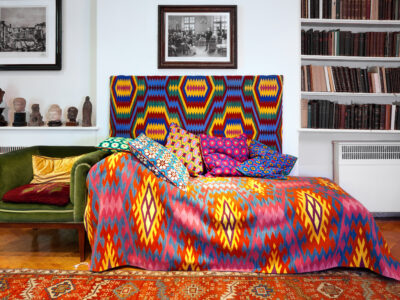
Sigmund Freud’s collection contains a small but intriguing selection of Chinese objects. To celebrate Chinese New Year, we’re taking a closer look at these fascinating objects.
Many of Freud’s most ‘famous’ objects are of Egyptian, Greek and Roman origin. But taking pride of place in the very centre of his desk stand two beautiful Chinese screens – a Qing Dynasty wooden screen with a white jade figure of a scholar and, in front of that, a pierced jade screen. Both were designed to be placed on a scholar’s desk, along with ornamental writing objects such as brushes, ink blocks and brush rests.

Jade and gold brooch, given as a gift to Anna Freud [Ref: 2014.1]
One of these, a beautiful jade and gold brooch with gold dragon detail, is a highlight of Anna Freud’s collection of otherwise quite ordinary costume jewellery. Little is know about where or when Freud acquired this piece or his other Chinese objects. He had been collecting jade, mainly bowls, for many years.
Jade was the sacred gem of China, symbolising many virtues, such as justice, courage and wisdom.

Lacquered figure of a Daoist sage [Ref: 3126]
Freud never travelled to China. In an exchange of letters with the philosopher and Chinese translator of his Autobiography, Zhang Shizhao 章士釗 (1881-1973), Freud confessed that his copy of the Encyclopaedia Britannica was the principal source on which he based the key references to China and Chinese culture in his writings on psychoanalysis.
Each Chinese object in Freud’s collection is intriguing in its own way. Earthenware tomb figures, stone and metal religious images, and many of the jades which Freud collected are not in themselves ‘treasures’ of Chinese art. Indeed, many may well have been manufactured to satisfy the growing global market of which Freud was a part. But taken together they provide a basis for exploring a number of themes of great significance. From the world of western collecting and ‘Orientalist’ thought, through themes of authenticity and falsehood, to the part which objects associated with death played in Freud’s thoughts on mourning and loss.
These themes and more will form the basis of a major new exhibition at the Freud Museum London in late-2021. ‘Freud and China’ will display Freud’s Chinese collection in a brand new way, exploring the place of China in Freud’s own thought, Freud’s reception in China, and the use of Freudian themes and ideas by Chinese writers and artists.
More information will be announced soon, but for now – Happy New Year!
祝你牛年吉祥!





Comments
Thank you for gathering information about Freud’s ties with China. I was wondering the Chinese version of Freud’s autobiography would be around the same time that the English version was published?